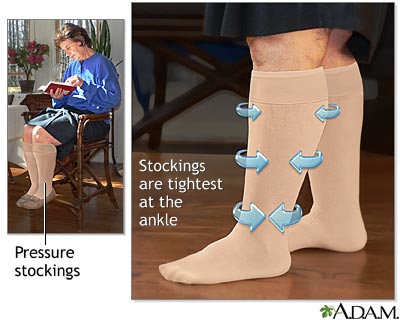Compression stockings
Compression hose; Pressure stockings; Support stockings; Gradient stockings; Varicose veins - compression stockings; Venous insufficiency - compression stockings
Images

I Would Like to Learn About:
Description
You wear compression stockings to improve blood flow in the veins of your legs. Compression stockings gently squeeze your legs to move blood up your legs. This helps prevent leg swelling and, to a lesser extent, blood clots.
If you have varicose veins, spider veins, or have just had surgery, your health care provider may prescribe compression stockings.
Wearing stockings helps with:
- Aching and heavy feeling in legs
- Swelling in legs
- Preventing blood clots, primarily after surgery or injury when you are less active
- Preventing complications of blood clots in the legs, such as post-phlebitic syndrome (pain and swelling in the leg)
Types of Compression Stockings
Talk to your provider about what kind of compression stockings are right for you. There are many different compression stockings. They come in different:
- Pressures, from light pressure to strong pressure
- Lengths, from knee-high to the top of the thigh
- Colors
Buying Compression Stockings
Contact your health insurance or prescription plan:
- Find out if they pay for compression stockings.
- Ask if your durable medical equipment benefit pays for compression stockings.
- Get a prescription from your provider.
- Find a medical equipment store where they can measure your legs so you get a good fit.
Wearing Compression Stockings
Follow instructions on how long each day you need to wear your compression stockings. You may need to wear them all day.
The stockings should feel tight around your legs. You will feel the most pressure around your ankles and less pressure higher up your legs.
Putting on Your Compression Stockings
Put on stockings first thing in the morning before you get out of bed. Your legs have the least amount of swelling early in the morning.
- Hold the top of the stocking and roll it down to the heel.
- Put your foot into the stocking as far as you can. Put your heel in the heel of the stocking.
- Pull the stocking up. Unroll the stocking over your leg.
- After the top of the stocking is in place, smooth out any wrinkles.
- Do not let the stockings bunch up or wrinkle.
- Knee length stockings should come to 2 fingers below the knee bend.
Compression Stockings can be Hard to put on
If it's hard for you to put on the stockings, try these tips:
- Apply lotion on your legs but let it dry before you put on the stockings.
- Use a little baby powder or cornstarch on your legs. This may help the stockings slide up.
- Put on rubber dishwashing gloves to help adjust the stockings and smooth them out.
- Use a special gadget called a stocking donner to slide the stocking over your foot. You can buy a donner at a medical supply store or online.
Wash Your Stockings Every Day
Keep the stockings clean:
- Wash the stockings each day with mild soap and water. Rinse and air dry.
- If you can, have 2 pairs. Wear 1 pair each day. Wash and dry the other pair.
- Replace your stockings every 3 to 6 months so that they maintain their compression and support.
When to Call the Doctor
If your stockings feel too uncomfortable, contact your provider. Find out if there is a different kind of stocking that will work for you. Do not stop wearing them without talking to your provider.
References
Alavi A, Lev-Tov H, Kirsner RS. Dressings. In: Bolognia JL, Schaffer JV, Cerroni L, eds. Dermatology. 5th ed. Philadelphia, PA: Elsevier; 2025:chap 145.
Holscher CM, Haut ER. Venous thromboembolic disease: mechanical and pharmacologic prophylaxis. In: Sidawy AN, Perler BA, eds. Rutherford's Vascular Surgery and Endovascular Therapy. 10th ed. Philadelphia, PA: Elsevier; 2023:chap 147.
Markovic JN, Shortell CK. Treatment of chronic venous disorders. In: Sidawy AN, Perler BA, eds. Rutherford's Vascular Surgery and Endovascular Therapy. 10th ed. Philadelphia, PA: Elsevier; 2023:chap 157.
BACK TO TOPReview Date: 7/15/2024
Reviewed By: Frank D. Brodkey, MD, FCCM, Associate Professor, Section of Pulmonary and Critical Care Medicine, University of Wisconsin School of Medicine and Public Health, Madison, WI. Also reviewed by David C. Dugdale, MD, Medical Director, Brenda Conaway, Editorial Director, and the A.D.A.M. Editorial team.

Health Content Provider
06/01/2025
|
A.D.A.M., Inc. is accredited by URAC, for Health Content Provider (www.urac.org). URAC's accreditation program is an independent audit to verify that A.D.A.M. follows rigorous standards of quality and accountability. A.D.A.M. is among the first to achieve this important distinction for online health information and services. Learn more about A.D.A.M.'s editorial policy, editorial process and privacy policy. A.D.A.M. is also a founding member of Hi-Ethics. This site complied with the HONcode standard for trustworthy health information from 1995 to 2022, after which HON (Health On the Net, a not-for-profit organization that promoted transparent and reliable health information online) was discontinued. |
The information provided herein should not be used during any medical emergency or for the diagnosis or treatment of any medical condition. A licensed medical professional should be consulted for diagnosis and treatment of any and all medical conditions. Links to other sites are provided for information only -- they do not constitute endorsements of those other sites. © 1997- 2025 A.D.A.M., a business unit of Ebix, Inc. Any duplication or distribution of the information contained herein is strictly prohibited.
